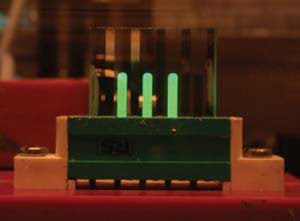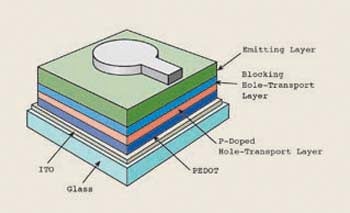Nadya Anscombe
Researchers from Universität zu Köln and Universität Potsdam, both in Germany, have developed polymer-based organic LEDs (OLEDs) that display an internal quantum efficiency approaching 100 percent and external quantum efficiencies that match the best values reported for multilayer small-molecule devices. The emitters have the added advantage of being solution-processable, which enables low fabrication costs.

The green polymer-based organic LEDs have an internal quantum efficiency approaching 100 percent.
Polymer OLEDs generally have been less efficient than their small-molecule counterparts because the multilayer structure required to achieve ultrahigh efficiencies is difficult to produce using the solution-processing techniques commonly employed in the fabrication of polymer OLEDs. The deposition of a second layer from solution tends to dissolve the first layer.
The scientists have overcome this problem by developing polymers that can be cross-linked using UV radiation before depositing the next layer. This makes the layers insoluble to each other and enables them to act as both hole injectors and electron blockers.

The cross-linked layers are insoluble to each other, and they act as both hole injectors and electron blockers.
“The cross-linking of the layers is of crucial importance,” said Klaus Meerholz of Institut für Physikalische Chemie at Universität zu Köln. He noted that the team developed the necessary chemistry, based on oxetane functions, over the past decade with Oskar Nuyken of Technische Universität München in Germany.

In their demonstration devices, the researchers deposited four layers from solution atop an ITO substrate: a water-soluble hole-injection layer, two cross-linked hole-transport layers and a polymer host doped with a phosphorescent iridium dye. The emitters were completed by thermal evaporation of a CsF/Al cathode.
“For our red- and blue-emitting devices, an additional improvement in efficiency may be achieved by depositing more layers with lower energy levels,” Meerholz said. “But our green devices have internal quantum efficiencies approaching unity, and more layers would not improve this.”
Grabbing attention
The group acknowledges that there is much to do before the OLEDs are commercially viable. Specifically, Dieter Neher from the Institut für Physik at Universität Potsdam noted that the lifetimes are too low. He said, however, that this issue is a result of the electrochemical stability of the compounds employed rather than of a more general problem with the concept.
The work has caught the attention of the small-molecule OLED community. Martin Pfeiffer, a researcher at Institut für Angewandte Photophysik in Dresden, Germany, characterized the demonstration of improved efficiencies as a breakthrough, but he cautioned that the competition between polymer and small-molecule OLEDs remains to be decided. He noted that polymer OLEDs enjoy an advantage in that they are solution-processable but that small-molecule OLEDs offer long lifetimes, high efficiencies for all colors and the reliability of vacuum deposition techniques
Advanced Materials, April 2006, pp. 948-954.